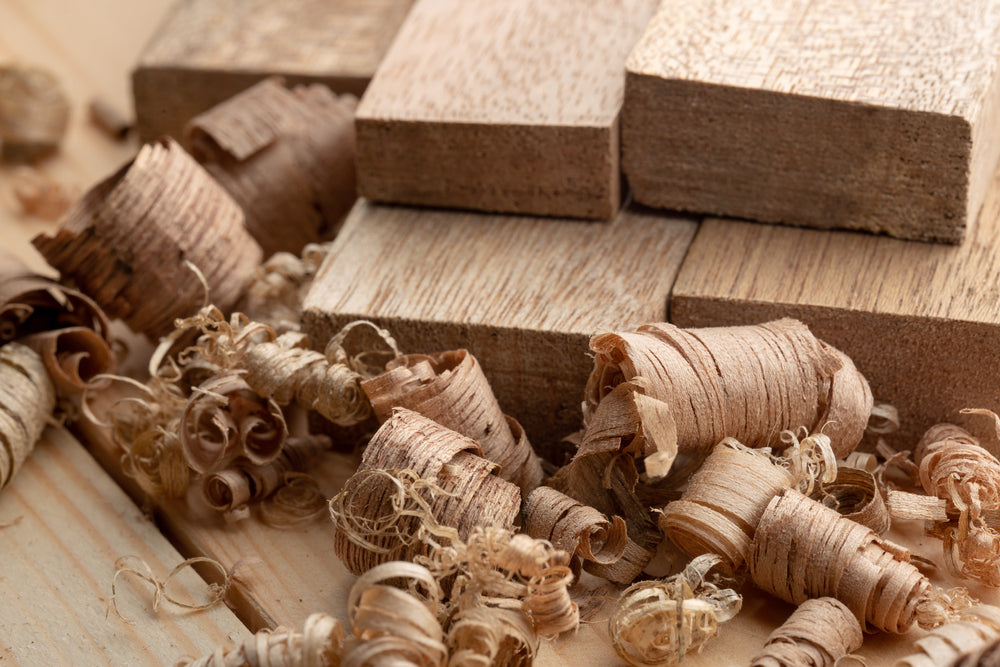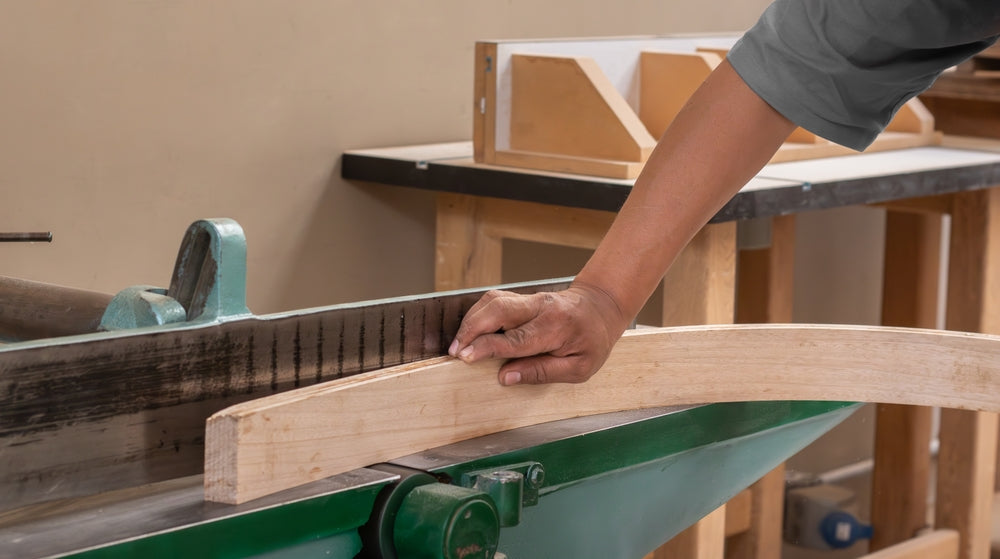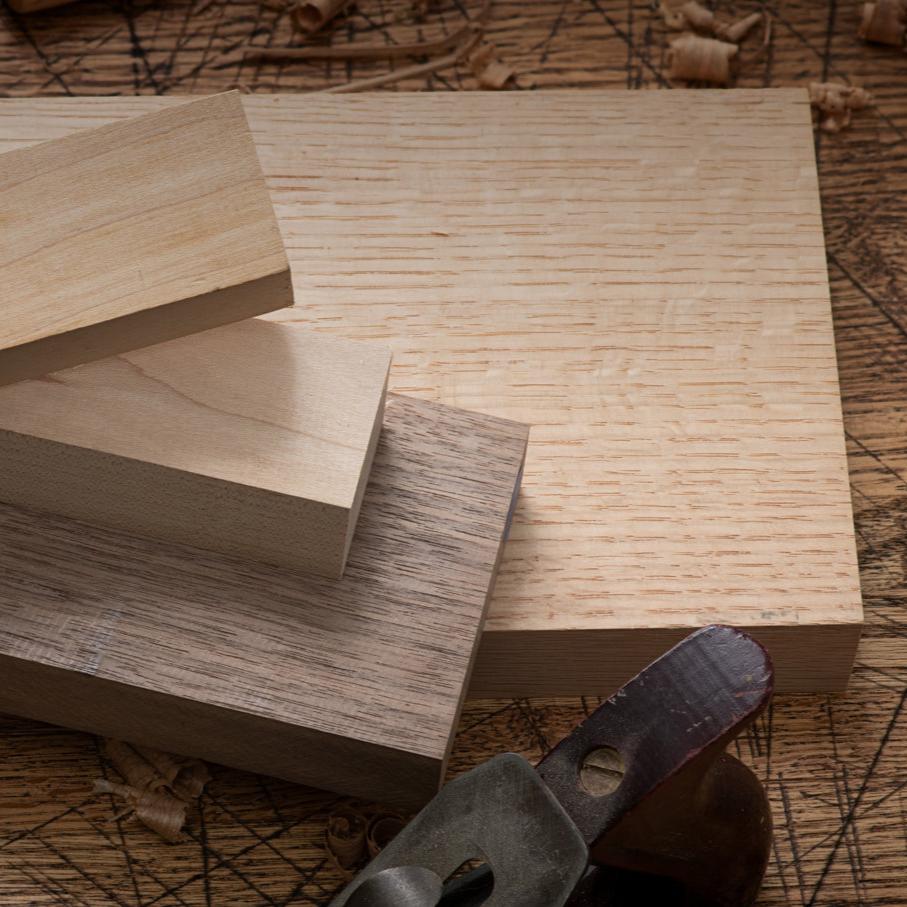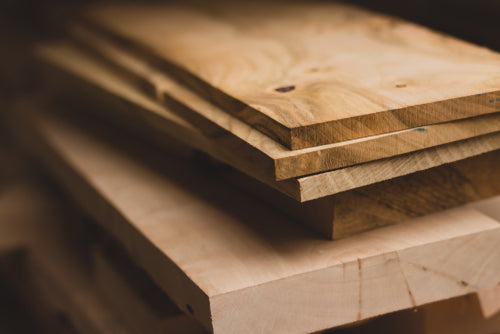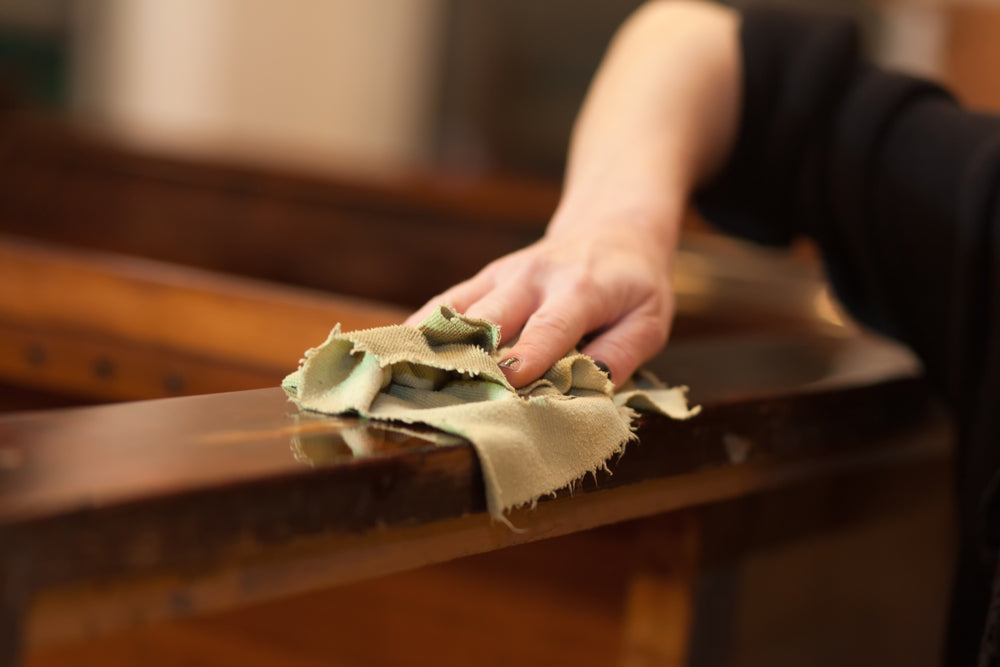If you're making anything out of wood, you'll be dealing with wood grain in one way or another. From wood floors and fine cabinets to hardwood furniture and structural timbers, grain patterns play a part in it all. Wood grains and the terms that describe them are as varied as trees in a forest, so let’s chat about key principles of wood grain that all woodworkers should know.
What is Wood Grain?
Wood grain is the unique pattern exposed on the sawn faces of a piece of lumber. Grain pattern is among the most important aspects of any woodwork, and selecting the right one can truly elevate a project.
Wood grain is all about exposing the internal elements of a tree on the face of a sawn piece of lumber. Growth rings that are formed during a tree's development are displayed on cut boards along with other types of wood cells, like pores. Depending on the sawing technique, these features can be exposed in a variety of ways to produce unique grain patterns.
A wide range of words are used to describe grain patterns and their appearance. This table offers a brief definition and description of the most commonly encountered types, which are discussed below.
|
Grain Type |
Characteristics |
Common Species |
|||
|
Open |
porous, rustic character |
white oak, red oak |
|||
|
Closed |
non-porous, smooth |
cherry, maple |
|||
|
Straight |
simple, parallel lines |
any, usually quarter sawn |
|||
|
Irregular |
diagonal, curving, or alternating lines |
any |
|||
|
Flat |
repeating V-shaped curves |
any, usually plain sawn |
|||
|
Fine |
non-porous, tightly packed lines |
cherry |
|||
|
Coarse |
porous, widely spaced lines |
oak, ash |
|||
|
Curl |
alternating wave pattern |
maple |
|||
|
Burl |
highly irregular swirling and sweeping lines |
any |
|||
Softwood vs. Hardwood Grain
Naturally, a key factor that determines a wood grain’s appearance is whether it was sourced from a hardwood or softwood tree. Unlike hardwoods, softwoods do not have pores and therefore cannot produce open-grained lumber. Softwood trees also tend to grow much faster than hardwoods, so their growth rings are typically spaced further apart and are more defined.
Building Blocks of Wood Grain
No matter how exotic or complex some may seem, all grain patterns are rooted in the structure of the wood itself. Wood is composed of long fibers that are mostly aligned vertically along the length of the tree’s trunk. The orientation and arrangement of different fibers is what produces a wood grain pattern.
Growth Rings
Growth rings are the most important feature of any wood grain. Due to seasonal weather changes, trees often expand quickly in the spring and slower throughout the summer.
The wood formed during rapid growth is lighter in color, while the slow-growth wood is darker. This results in a contrasting light-and-dark ring pattern that is expanded each year as the tree grows.
While many are familiar with viewing growth rings on the round face of a sawn log or trunk, they appear differently in processed lumber. When a log is cut along its length to produce boards, the dark ring lines can be viewed from another perspective on each board's face, where they create unique patterns. The overall appearance depends on both the tree and the method used to saw it. A ring may appear as a single stripe on one board or a gently curving ribbon on another.
Pores
Hardwood species use long, tube-like channels called pores to distribute water and nutrients among their cells. When a piece of hardwood timber is cut into lumber, these pores are displayed in the grain of the resulting wood.
In some hardwood species, these pores are actually visible to the naked eye. Therefore, the size, presence, and distribution of pores also contribute to a wood's grain.
In some species, pores can be naturally filled by internal growths called tyloses. These small ball-shaped structures fill and block the pore tubes, preventing the flow of water and nutrients. This most commonly occurs in sections of wood that no longer need nutrients, but can also be a method for stopping the spread of an infection within a tree.
If enough tyloses are present, the pores will be completely filled and invisible to the naked eye. This can significantly change the appearance of porous wood.

Types of Wood Grain Patterns
While it's easy to get lost in the dozens of terms used to describe different wood grain types, understanding this terminology is the key to selecting the perfect wood for the job.
Open Grain
Open grain is produced when a large amount of pores are present on the face of the lumber piece. In many species, pores are visible without magnification, which gives the sawn wood a distinct rough or textured appearance. This makes open-grained woods like red oak and white oak desirable for applications that benefit from wood with unique and rustic character, like wood flooring.
Closed Grain
The opposite of open grain is closed grain, which appears in lumber with small, invisible pores. This gives the grain pattern a smooth and refined appearance. Closed-grain species like cherry and maple are popular for high-end furniture, musical instruments, and decorative woodwork.
A special exception occurs when tyloses cause open-grained woods to appear closed by filling all of the visible pores. This is especially prevalent in white oak, where older heartwood often appears non-porous due to almost total blockage of the pores. Newer wood, however, displays a typical open-grained pattern.
Straight Grain
Straight grain is produced when the wood fibers run along the length of the tree trunk without changing directions. It is defined by a pattern of mostly parallel lines that are parallel with the trunk’s centerline. The spacing of the growth rings defines the spacing of these lines, so slow-growing trees often have very dense patterns.
Straight may be the simplest of all wood grains, but that doesn't mean it's undesirable. This simple wood grain is a great choice for subtle applications that shouldn't be dominated by a bolder grain pattern, such as tool handles or structural members. It can be produced from any tree with a uniform internal structure.
Straight grain is typically produced by quarter or rift sawing a log with uniform internal grain structure. We’ll discuss these cutting styles in more detail later, but the basic principle is that the intersection of the cut and the log’s growth rings determines the type of grain that will appear in the lumber. Quarter and rift cuts both intersect the growth rings at an ideal angle for producing a straight grain pattern with evenly spaced parallel lines.
Irregular Grain
This type of wood grain is the result of wood fibers that do not perfectly align with the direction of the tree trunk’s centerline. This type of grain can be unpredictable and varies in appearance depending on the direction the fibers took while the tree was growing. It is similar in appearance to straight grain, but may run in curving, diagonal, or even alternating directions compared to standard straight grain.
Flat Grain
Wood with flat grain is defined by a pattern of repeating curved or U-shaped lines shown on its face. This type of grain is not produced by unique fiber alignment but instead results from the way the log was sawn.
Pieces of lumber that are plain sawn from an area near the outer edge of the tree produce unique flat grain patterns, while other sawing techniques can produce different patterns from the same tree. Because of this, flat grain is very common and can be produced from a wide variety of tree species. A particularly desirable type of flat grain pattern is cathedral figure, which is defined by repeating nested V-shapes that resemble a large church.
Fine Grain
Also called fine texture, this grain pattern is sourced from wood with non-visible pores, small fibers, and tightly spaced growth rings. It often results from slow-growing, closed-grained hardwoods like cherry.
Fine wood grain is prized for its sleek appearance, smooth texture, and ease of finishing. Because of this, it is commonly employed for cabinetry and decorative purposes.
Coarse Grain
Contrary to fine grain, coarse grain originates from species with visible pores, large fibers, and widely spaced rings. This type of wood grain is present in many of the popular open-grained woods, including white oak and ash.
It is well-suited to producing wood products with vibrant character and a classic wood appearance. Common uses are rustic hardwood flooring, tabletops, and gunstocks.
Curly Grain
Curly grain is a rare wave-like pattern caused when wood fiber layers grow and align in alternating directions within the tree’s trunk. When exposed in cut lumber, the two-grain directions that make up the pattern reflect light differently. As a result, a piece of lumber with a completely flat surface will produce a striking 3D wave pattern that makes this one of the most sought-after wood grain types.
Although the exact cause of curly grain cannot be definitively proven, it is known to occur most often in maple wood. The beautiful and intriguing appearance of curly maple has made it a long-standing staple of fine furniture.
Burl Grain
If curly grain is exotic, burl grain is doubly so. This rare and stunning grain pattern is produced when wood is cut from round deformations in a tree called burls. These cancer-like growths can be caused by infections or damage to the tree, and expand rapidly with a disorderly grain.
Due to this abnormal growth, burl wood grains exhibit beautiful swirling and sweeping patterns that are highly prized for decorative use. Burl can occur in any wood species since it is a result of external factors.
How Sawing Methods Affect Wood Grain
The internal structure of wood is only part of the picture when it comes to grain appearance - the rest is determined by how that structure is exposed. A log being processed into lumber can be sawn in a variety of ways, each exposing the fiber layers differently and in turn, affecting the grain pattern that appears on the cut face.
Furthermore, unsealed wood is constantly exchanging moisture with the surrounding air, which causes it to swell or shrink. Each sawing method opens the wood grain differently and encourages a certain type of shrinkage. Boards that do not shrink evenly will become warped, making the sawing technique is an important consideration.
Plain Sawing
Also called flat sawing, this method is the simplest way to slice a log. This makes it very common in lumber production, as it enables mills to generate more boards from a single tree trunk in a shorter amount of time.
Plainsawn lumber is milled by cutting a log into parallel horizontal slices along its length. Each slice intersects the tree's growth rings at a different point in their curvature, so this method can actually create boards with varying grain patterns from a single log. When a log is cut this way, the majority of slices form a 0 to 30-degree angle at the point where they intersect a ring.
When a board is plain sawn from a log with straight, uniform internal grain, the cut travels along some of the growth rings as it moves along the trunk. On the sawn faces, both the rings and the spacing between them appear wider than they actually are because they are being sliced at such a narrow angle.
As the log narrows, the cut gradually moves through the growth rings and the separate lines draw together into a V shape. This produces a pattern of repeating nested arches referred to as cathedral figure. Cathedral figure cannot be obtained through other sawing methods because it requires a shallow intersection angle between the cut and rings.
Plainsawn lumber has several advantages when it comes to exposing attractive wood grain. By cutting slices near the outer edges of the log, plain sawing produces boards with unique, rustic flat grain patterns that are prized for aesthetic applications. It is also the most efficient way to mill a log, so plainsawn lumber is typically cheaper and more available than other lumber.
However, boards produced this way are prone to a type of uneven shrinkage called cupping. Cupped boards have long edges that turn upwards, making the piece appear trough-like and severely reducing its usability.
Quarter Sawing
Quarter sawing is a more complex technique than plain sawing, but it results in finer lumber and is popular for making high-grade boards. In this method, the log is divided into quarters that are in turn cut along their lengths so that each slice intersects the growth rings at a nearly 90-degree angle. When looking at the circular end of a log, this would correspond to the zones near the midpoint.
Because quarter sawing involves cuts that intersect growth rings at nearly 90 degrees, the spacing and thickness of the rings are directly transferred to the lines on the sawn face. Therefore, a log with uniform internal grain will produce a simple straight grain pattern of thin parallel lines on quartersawn lumber.
Quarter-sawn wood grain has certain advantages when compared to wood produced by other sawing methods. According to the USDA Forest Product Laboratory's Wood Handbook, quarter-sawn lumber does not shrink or swell as easily as plainsawn lumber. It is also ideal for producing several special types of wood grain.
In white and red oak wood, quarter sawing often exposes rays - wood cells that run horizontally from the inside of the tree towards the bark - on the cut surface of the lumber. The result is a unique pattern of slightly wavy ribbons or streaks in the exposed surface wood grain.
According to the Wood Database, this sawing method is also the best way to produce the famous curly pattern commonly found in maple wood. The prized shimmering wavy pattern is either diminished or altogether missing in flat-sawn wood from the same section of the trunk.
However, quarter sawing is a more wasteful process than flat sawing, so this type of lumber is more expensive and harder to find. It also tends to produce simple straight grain with little character when utilized on wood species that do not have special features like rays or curl.
Rift Sawing
Rift sawing is a rare method that is often confused with quarter sawing, but is actually a different process. As defined by the Architectural Woodwork Institute's Architectural Woodworking Standards, rift-sawn lumber is produced from cuts that intersect growth rings at an angle of 30 to 60 degrees. When looking at the circular end of a log, this would correspond the the zones between the top and midpoint.
Rift-sawn lumber can be thought of as a compromise between plain sawing and quarter sawing - the process is moderately efficient and produces grain patterns of moderate character. Due to the rarity of the method, however, this type of lumber can be difficult to find.
Rift sawing tends to produce straight grain in the same manner that quarter sawing does. Due to its intermediate intersection angle with the growth rings, rift-sawn lumber may exhibit somewhat wider lines and spacing than quarter-sawn grain. However, it generally still retains the straight grain pattern of evenly spaced parallel lines.
Conclusion
Wood grain patterns can be a complex topic, but understanding them is crucial to creating just the right look and feel in a project. Not only is the species important, but the way it is processed is crucial as well. Next time you've got grain on the brain, be sure to browse North Castle Hardwoods' excellent selection of quality plain, quarter, and rift-sawn species to find exactly what you need.
